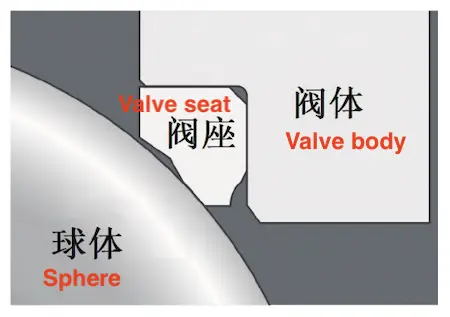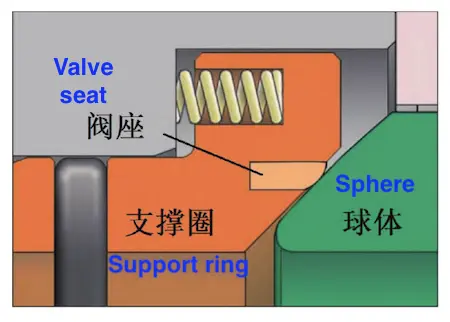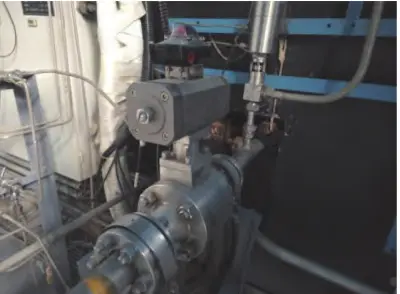Materials of Soft-Seated Ball Valve Seats
Mar 27, 2025
The soft-seated ball valve is a widely used valve, favored for its fast operation, simple structure, and reliable sealing. The polymer used in the valve seat plays a key role in determining its sealing performance and service life. This paper discusses the material composition, manufacturing processes, applicable standards, mechanical properties, temperature ranges, and typical sealing structures of different polymer materials. It aims to provide a comprehensive understanding of their properties and serve as a guide for selecting materials for soft-seated ball valve seats.
Advancements in polymer science have improved the performance of soft-seated ball valves and expanded their applications. This article examines several polymer materials used in valve seats, including PTFE, RPTFE, MPTFE, NYLON, DEVLON, PEEK, and PCTFE.
PTFE (polytetrafluoroethylene) is a widely used sealing material in the manufacturing of ball valve seats. PTFE for valve seats is produced using either compression or extrusion molding methods, with the standard grade specified as ASTM D4894 Type I. PTFE powder tends to condense and agglomerate when exposed to vibration, impact, or temperature fluctuations, necessitating controlled storage conditions. PTFE granules help reduce condensation and agglomeration, making them a preferred choice for many applications. The pre-molding specifications for PTFE granules are listed in Table 1.
Table 1 Testing requirements of PTFE granular materials
|
Bulk Density / (g/L) |
Average Particle Diameter / μm |
Moisture Content / % |
Melting Peak Temperature / °C |
|
|
Initial
|
The second time |
|||
|
675 ± 50 |
375 ± 75 |
0.04 |
More than 5°C higher than the second |
327 ± 10 |
Molded PTFE undergoes sintering, a heat treatment process that improves its mechanical properties by promoting recrystallization and the formation of a denser structure. The mechanical properties of sintered PTFE are shown in Table 2.
Table 2: Mechanical Properties of PTFE
|
Density (g/cm³) |
Tensile Strength (MPa) |
Hardness (Shore D) |
Elongation at Break (%) |
Deformation Under Load (% at 13.8 MPa, 25°C, for 24 hours) |
|
2.13 - 2.18 |
≥17.2 |
≥50 |
200 |
14 - 28 |
Table 3: Temperature/Pressure Rating of PTFE Valve Seats
|
Temperature (°C) |
Pressure/MPa |
||
|
NPS ≤ 2 (MPa) |
2 < NPS ≤ 4 (MPa) |
NPS > 4 (MPa) |
|
|
-29 - 38 |
6.90 |
5.10 |
2.10 |
|
50 |
6.60 |
4.90 |
2.10 |
|
75 |
5.67 |
4.22 |
1.84 |
|
100 |
4.74 |
3.54 |
1.58 |
|
125 |
3.81 |
2.86 |
1.32 |
|
150 |
2.88 |
2.18 |
1.06 |
|
175 |
1.95 |
1.50 |
0.80 |
PTFE exhibits exceptional chemical/solvent resistance, excellent dielectric properties, self-lubrication, low friction coefficient, and superior aging resistance. This material is ideally suited for floating ball valve seat. As shown in Figure 1, the sealing structure requires no special surface treatment of the ball.
Key advantages of PTFE valve seats:
- Minimal operating torque
- Superior corrosion resistance for aggressive media
- Intrinsic purity for ultrapure service applications

Figure 1: Structure of Floating Ball Valve Seats
RPTFE (Reinforced Filled PTFE) is a polymer material commonly used in valve seats. The material requirements for RPTFE are as follows:
(1) The average particle size of the raw material should be less than 100 µm.
(2) RPTFE is typically reinforced with glass fiber, metal, other inorganic materials, or polymers, which must be capable of withstanding the sintering temperature of PTFE (327–380°C) during processing.
The typical formulation of RPTFE for ball valve seats consists of 15% glass fiber-filled PTFE, conforming to ASTM D4745 standards. This section focuses on this specific formulation. The molding and sintering processes used for RPTFE are identical to those used for PTFE. The mechanical properties of sintered RPTFE are summarized in Table 4.
Table 4: Mechanical Properties of RPTFE
|
Properties |
Value |
|
Density (g/cm³) |
2.13–2.18 |
|
Tensile Strength (MPa) |
≥19.6 |
|
Hardness (Shore D) |
≥58 |
|
Elongation at Break (%) |
220 |
|
Deformation Under Load (% at 13.8 MPa, 25°C, for 24h) |
6–16 |
Table 5: Temperature/Pressure Rating of RPTFE Valve Seats
|
Temperature (°C) |
NPS ≤ 2 (MPa) |
2 < NPS ≤ 4 (MPa) |
NPS > 4 (MPa) |
|
-29 - 38 |
7.59 |
5.10 |
2.67 |
|
50 |
7.30 |
5.00 |
2.61 |
|
75 |
6.33 |
4.37 |
2.27 |
|
100 |
5.37 |
3.73 |
1.91 |
|
125 |
4.40 |
3.10 |
1.57 |
|
150 |
3.43 |
2.47 |
1.22 |
|
175 |
2.47 |
1.83 |
0.87 |
|
200 |
1.50 |
1.20 |
0.53 |
RPTFE maintains PTFE's core characteristics while demonstrating superior dimensional stability under thermal and mechanical loads. The material shows enhanced cold flow resistance, improved wear characteristics, and reduced linear expansion coefficient, though with marginally decreased elongation at break, dielectric properties, and corrosion resistance. Like PTFE, RPTFE serves effectively in floating ball valve seat, employing the identical sealing configuration shown in Figure 1 without requiring special ball surface treatment.
Key advantages of RPTFE valve seats:
- Maintaining material purity for clean process media applications
- Demonstrating extended operational lifespan versus standard PTFE
Modified polytetrafluoroethylene (MPTFE) for valve seats is manufactured via compression or extrusion molding per ASTM D4894 Type III Grade 1 specifications. Table 6 details the pre-molding pellet requirements. The fine-particle molding process yields greater material density, while optimized sintering promotes complete crystallization. Table 7 presents the resulting mechanical properties.
Table 6: MPTFE Granule Testing Requirements
|
Bulk Density (g/L) |
Granule Diameter (µm) |
Moisture Content (%) |
Melting point peak temperature/°C
|
|
|
Initial |
The second time |
|||
|
400±125 |
<100 |
0.04 |
5°C higher than the second |
327 ± 10 |
Table 7: Mechanical Properties of MPTFE
|
Density (g/cm³) |
Tensile Strength (MPa) |
Hardness (Shore D) |
Elongation at Break (%) |
Deformation Under Load (%) |
|||
|
13.8 MPa, 25°C, for 24h
|
13.8 MPa, 100°C, for 24h
|
6.9 MPa, 200°C, for 24h |
|||||
|
2.14 - 2.22 |
≥28 |
≥54 |
450 |
3-11
|
7-22 |
4-15 |
|
Table 8: Temperature/Pressure Rating of MPTFE Valve Seats
|
Temperature (°C) |
Pressure (MPa) (NPS ≤4) |
Pressure (MPa) (NPS >4) |
|
-29 - 38 |
11.0 |
6.7 |
|
50 |
10.70 |
6.52 |
|
75 |
9.82 |
5.96 |
|
100 |
8.94 |
5.41 |
|
125 |
8.05 |
4.85 |
|
150 |
7.17 |
4.30 |
|
175 |
6.29 |
3.75 |
|
200 |
5.41 |
3.23 |
MPTFE retains all the advantages of PTFE, with significant improvements in dimensional stability, elongation at break, and wear resistance under high-temperature and mechanical stress. The applicable temperature range of MPTFE is -100 to 200°C, with temperature and pressure ratings provided in Table 8. MPTFE valve seats are applicable to the following valve sizes:
- For valves with a nominal pipe size (NPS) of ≤4, the maximum pressure rating is Class 600.
- For valves with a nominal pipe size (NPS) >4, the maximum pressure rating is Class 300.
Nylon, a type of polyamide, is commonly abbreviated as PA. The most commonly used nylon in valves is PA12, which serves as the example in this section. PA12 used in ball valve seats is manufactured via molding or extrusion processes, in accordance with ASTM D6779. The material grade is designated as PA042GI5. The grade notation is interpreted as follows: PA stands for polyamide; 04 refers to the material group code, indicating PA12; 2 represents the thermally stable material grade; and G15 denotes the material type, which is filled with 15% glass fiber. The mechanical properties of PA12 are shown in Table 9.
Table 9: Mechanical Properties of PA12
|
Properties |
Value |
|
Density |
1.10 - 1.20 g/cm³ |
|
Tensile Strength |
≥75 MPa |
|
Hardness |
≥75 Shore D |
|
Elastic Modulus |
3000 MPa |
|
Deformation under Load |
2 - 3% (at 13.8 MPa, 25°C, for 24 hours) |
The temperature range for PA12 is -50°C to 120°C, with a pressure rating of 1500 LB. The temperature and pressure ratings of valves with PA12 valve seats are determined by the material of the metal shell. PA12 offers excellent electrical insulation, wear resistance, impact resistance, and chemical corrosion protection. PA12 is suitable for valves of all sizes and performs effectively in both floating and trunnion ball valves. The design of the floating ball valve is shown in Figure 1, and the design of the trunnion ball valve is shown in Figure 2. The ball surface requires no special treatment.
The advantages of PA12 valve seats are as follows:
(1) Reliable sealing performance under medium and high-pressure conditions
(2) Low operating torque of the valve seat
(3) Excellent low-temperature sealing performance

Figure 2: Trunnion Ball Valve Seat Structure
DEVLON is a high-performance nylon manufactured by James Walker in the UK. The most commonly used material in valves is DEVLON V-API. This section focuses on the properties and applications of this material. The mechanical properties of DEVLON V-API are listed in Table 10.
Table 10: Mechanical Properties of DEVLON
|
Property |
Unit |
Value |
|
Density |
g/cm³ |
1.14 |
|
Tensile Strength |
MPa |
≥79 |
|
Hardness |
Shore D |
≥78 |
|
Elastic Modulus |
MPa |
4138 |
|
Deformation Under Load |
% (13.8 MPa, 25°C, 24 h) |
1 - 2 |
Compared to PA12, DEVLON V-API offers several advantages, including improved dimensional stability, a wider applicable temperature range, and excellent wear resistance. The applicable temperature range of DEVLON V-API is -50°C to 175°C, with a maximum pressure rating of 1500 LB. The temperature and pressure ratings for valves with DEVLON V-API valve seats depend on the material of the valve body. Additionally, DEVLON V-API is suitable for valves of all sizes and performs well in both floating and trunnion ball valves. Figures 1 and 2 show the typical structures of floating and trunnion ball valves, respectively. The surface of the ball does not require any special treatment. The advantages of DEVLON V-API valve seats are as follows:
(1) Reliable sealing at medium and high pressures
(2) Low operating torque
(3) Excellent low-temperature sealing performance
(4) Longer valve switching life compared to PA12 valve seats
PEEK is a high-performance polymer material commonly used in various industrial applications. PEEK used in ball valve seats is manufactured through molding or extrusion processes and complies with ASTM D8033 standards. The material grade is designated as PEEK-0121. The grade designation corresponds to the following specifications:
- 01 denotes the material's application group (general purpose).
- 2 denotes the process grade (low flow).
- 1 denotes the composition grade (no filler).
The mechanical properties of PEEK are shown in Table 11.
Table 11 Mechanical properties of PEEK
|
Properties |
Value |
|
Density (g/cm³) |
1.28 - 1.32 |
|
Tensile Strength (MPa) |
≥93 |
|
Hardness (Shore D) |
≥84.5 |
|
Elastic Modulus (MPa) |
≥3600 |
|
Deformation under Load (%) |
1 - 2 (at 13.8 MPa, 25°C, 24h) |
PEEK (Polyetheretherketone) is a high-performance thermoplastic polymer known for its excellent mechanical properties over a wide temperature range. Key properties of PEEK include:
(1) Superior high-temperature resistance, withstanding temperatures up to 250°C
(2) High toughness, with an elongation at break greater than 30% and an impact strength of ≥53 J/cm²
(3) Exceptional fatigue resistance, with a fatigue life of up to 10^7 cycles
(4) Self-lubricating and wear-resistant, ideal for use in non-metallic bearings
(5) Excellent chemical corrosion resistance, with minimal expansion or discoloration after chemical immersion while retaining superior mechanical properties
PEEK is suitable for use in temperatures ranging from -100°C to 250°C and pressure ratings up to 2500 LB. The temperature or pressure ratings of valves with PEEK valve seats depend on both the material of the valve seat and the metal shell. PEEK is compatible with valves of all sizes and is extensively used in high-pressure floating and trunnion ball valves.
The typical structure of a floating ball valve is illustrated in Figure 1, and the typical structure of a trunnion ball valve is shown in Figure 2. It is recommended that the ball surface undergo hardening treatments, such as low-temperature nitriding or chemical nickel plating, to enhance wear resistance and durability. Key benefits of PEEK valve seats include:
(1) Reliable sealing, ideal for emergency safety protection applications
(2) Outstanding performance at high temperature and pressure, making it the preferred material for high-temperature, high-pressure ball valves
(3) Excellent wear and fatigue resistance, suitable for high-frequency, and long-life applications
(4) Superior chemical corrosion resistance, widely used in the chemical industry
PCTFE (polychlorotrifluoroethylene) is a high-performance thermoplastic commonly used in critical sealing applications. For ball valve seats, PCTFE is manufactured using compression molding or extrusion processes in accordance with ASTM D7211 specifications. Table 12 presents its key mechanical properties.
Table 12 Mechanical properties of PCTFE
|
Properties |
Value |
|
Density (g/cm³) |
2.11 - 2.17 |
|
Tensile Strength (MPa) |
≥32 |
|
Hardness (Shore D) |
75 - 85 |
|
Crack Growth Rate (%) |
≥50 |
Besides its excellent thermal and chemical stability, PCTFE offers extremely low hygroscopicity and permeability. It also provides high resistance to cold flow, exceptional hardness and toughness, superior dimensional stability, and excellent low-temperature performance. PCTFE is ideal for manufacturing valve sealing components in low-temperature fluid applications. PCTFE has a temperature range of -200°C to 125°C, with a pressure rating of ≤900 LB. The temperature/pressure ratings for valves with PCTFE valve seats are determined by the metal shell material. PCTFE is suitable for valves of all sizes. The structure of the floating ball valve is shown in Figure 1, and that of the trunnion ball valve is shown in Figure 2. The ball surface does not require special treatment. The advantages of PCTFE valve seats include:
(1) Excellent low-temperature performance
(2) Reliable high-pressure sealing
Several factors influence the mechanical properties of plastic seals, including the particle size of the raw material, the pressure ramp rate during molding, and the sintering temperature. The material standards referenced in this article provide benchmark values for material properties, but they are intended solely for reference purposes, not material selection. It is recommended that professionals select valve seat materials by carefully considering the design and performance requirements, operating environment, manufacturing process, cost, and the material's inherent properties.
Previous: Durability Testing of Soft-Seated Gate Valves for Water Supply and Drainage
Next: Flow Field Characteristics and Erosion Mechanisms in Ball Valves with Various Seat Structures


